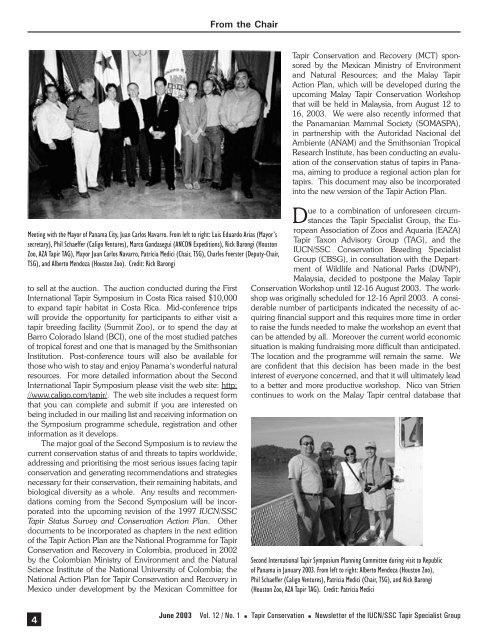Download now - Tapir Specialist Group
Download now - Tapir Specialist Group
Download now - Tapir Specialist Group
You also want an ePaper? Increase the reach of your titles
YUMPU automatically turns print PDFs into web optimized ePapers that Google loves.
Meeting with the Mayor of Panama City, Juan Carlos Navarro. From left to right: Luis Eduardo Arias (Mayor’s<br />
secretary), Phil Schaeffer (Caligo Ventures), Marco Gandasegui (ANCON Expeditions), Rick Barongi (Houston<br />
Zoo, AZA <strong>Tapir</strong> TAG), Mayor Juan Carlos Navarro, Patrícia Medici (Chair, TSG), Charles Foerster (Deputy-Chair,<br />
TSG), and Alberto Mendoza (Houston Zoo). Credit: Rick Barongi<br />
to sell at the auction. The auction conducted during the First<br />
International <strong>Tapir</strong> Symposium in Costa Rica raised $10,000<br />
to expand tapir habitat in Costa Rica. Mid-conference trips<br />
will provide the opportunity for participants to either visit a<br />
tapir breeding facility (Summit Zoo), or to spend the day at<br />
Barro Colorado Island (BCI), one of the most studied patches<br />
of tropical forest and one that is managed by the Smithsonian<br />
Institution. Post-conference tours will also be available for<br />
those who wish to stay and enjoy Panama‘s wonderful natural<br />
resources. For more detailed information about the Second<br />
International <strong>Tapir</strong> Symposium please visit the web site: http:<br />
//www.caligo.com/tapir/. The web site includes a request form<br />
that you can complete and submit if you are interested on<br />
being included in our mailing list and receiving information on<br />
the Symposium programme schedule, registration and other<br />
information as it develops.<br />
The major goal of the Second Symposium is to review the<br />
current conservation status of and threats to tapirs worldwide,<br />
addressing and prioritising the most serious issues facing tapir<br />
conservation and generating recommendations and strategies<br />
necessary for their conservation, their remaining habitats, and<br />
biological diversity as a whole. Any results and recommendations<br />
coming from the Second Symposium will be incorporated<br />
into the upcoming revision of the 1997 IUCN/SSC<br />
<strong>Tapir</strong> Status Survey and Conservation Action Plan. Other<br />
documents to be incorporated as chapters in the next edition<br />
of the <strong>Tapir</strong> Action Plan are the National Programme for <strong>Tapir</strong><br />
Conservation and Recovery in Colombia, produced in 2002<br />
by the Colombian Ministry of Environment and the Natural<br />
Science Institute of the National University of Colombia; the<br />
National Action Plan for <strong>Tapir</strong> Conservation and Recovery in<br />
Mexico under development by the Mexican Committee for<br />
4<br />
From the Chair<br />
<strong>Tapir</strong> Conservation and Recovery (MCT) sponsored<br />
by the Mexican Ministry of Environment<br />
and Natural Resources; and the Malay <strong>Tapir</strong><br />
Action Plan, which will be developed during the<br />
upcoming Malay <strong>Tapir</strong> Conservation Workshop<br />
that will be held in Malaysia, from August 12 to<br />
16, 2003. We were also recently informed that<br />
the Panamanian Mammal Society (SOMASPA),<br />
in partnership with the Autoridad Nacional del<br />
Ambiente (ANAM) and the Smithsonian Tropical<br />
Research Institute, has been conducting an evaluation<br />
of the conservation status of tapirs in Panama,<br />
aiming to produce a regional action plan for<br />
tapirs. This document may also be incorporated<br />
into the new version of the <strong>Tapir</strong> Action Plan.<br />
Due to a combination of unforeseen circumstances<br />
the <strong>Tapir</strong> <strong>Specialist</strong> <strong>Group</strong>, the European<br />
Association of Zoos and Aquaria (EAZA)<br />
<strong>Tapir</strong> Taxon Advisory <strong>Group</strong> (TAG), and the<br />
IUCN/SSC Conservation Breeding <strong>Specialist</strong><br />
<strong>Group</strong> (CBSG), in consultation with the Department<br />
of Wildlife and National Parks (DWNP),<br />
Malaysia, decided to postpone the Malay <strong>Tapir</strong><br />
Conservation Workshop until 12-16 August 2003. The workshop<br />
was originally scheduled for 12-16 April 2003. A considerable<br />
number of participants indicated the necessity of acquiring<br />
financial support and this requires more time in order<br />
to raise the funds needed to make the workshop an event that<br />
can be attended by all. Moreover the current world economic<br />
situation is making fundraising more difficult than anticipated.<br />
The location and the programme will remain the same. We<br />
are confident that this decision has been made in the best<br />
interest of everyone concerned, and that it will ultimately lead<br />
to a better and more productive workshop. Nico van Strien<br />
continues to work on the Malay <strong>Tapir</strong> central database that<br />
Second International <strong>Tapir</strong> Symposium Planning Committee during visit to Republic<br />
of Panama in January 2003. From left to right: Alberto Mendoza (Houston Zoo),<br />
Phil Schaeffer (Caligo Ventures), Patrícia Medici (Chair, TSG), and Rick Barongi<br />
(Houston Zoo, AZA <strong>Tapir</strong> TAG). Credit: Patrícia Medici<br />
June 2003 Vol. 12 / No. 1 n <strong>Tapir</strong> Conservation n Newsletter of the IUCN/SSC <strong>Tapir</strong> <strong>Specialist</strong> <strong>Group</strong>










